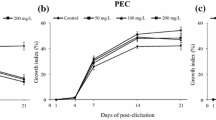Abstract
Under the elicitation of protein elicitor isolated from the culture mycelia of Tuber melanosporum, the biosynthesis of ganoderic acids (GA) was significantly stimulated during Ganoderma lucidum fermentation. Compared with our previous results that, GA content was inhibited by polysaccharide elicitor isolated from T. melanosporum, while improved by the elicitor of polysaccharide and protein, protein was identified to be the exact component inducing GA biosynthesis in this work. G. lucidum cell growth was significantly inhibited by elicitor of polysaccharide and protein, and polysaccharide elicitor did not inhibit the cell growth. In this work, the remarkable inhibition on the cell growth was considerably eliminated under the elicitation of protein elicitor isolated from T. melanosporum. These suggested maybe the interaction of polysaccharide and protein components existed in the inhibition on the cell growth of G. lucidum. Not only GA content but also total GA accumulation obtained the highest values after the elicitation of protein elicitor. The maximal GA production of 260.5 ± 5.6 mg/L was 31.2% higher than the control. Under the elicitation of protein elicitor, the production of extracellular polysaccharide (EPS) and the content of intracellular polysaccharide (IPS) were also enhanced; however, total IPS accumulation was lower. GA biosynthesis was also significantly affected by the addition time of protein elicitor, whose optimal value was the culture of day 4.





Similar content being viewed by others
References
Tang YJ, Zhu LW, Li HM, Li DS (2007) Submerged culture of mushrooms in bioreactors-challenges, current state-of-the-art, and future prospects. Food Technol Biotechnol 45:221–229
Paterson RRM (2006) Ganoderma-A therapeutic fungal biofactory. Phytochemistry 67:1985–2001
Zhang M, Cui SW, Cheung PCK, Wang Q (2007) Antitumor polysaccharides from mushrooms: A review on their isolation process, structural characteristics and antitumor activity. Trends Food Sci Technol 18:4–19
Tang W, Liu JW, Zhao WM, Wei DZ, Zhong JJ (2006) Ganoderic acid T from Ganoderma lucidum mycelia induces mitochondria mediated apoptosis in lung cancer cells. Life Sci 80:205–211
Lin SB, Li CH, Lee SS, Kan LS (2003) Triterpene-enriched extracts from Ganoderma lucidum inhibit growth of hepatoma cells via suppressing protein kinase C, activating mitogen-activated protein kinases and G2-phase cell cycle arrest. Life Sci 72:2381–2390
El-Mekkawy S, Meselhy MR, Nakamura N, Tezuka Y, Hattori M, Kakiuchi N, Shimotohno K, Kawahata T, Otake T (1998) Anti-HIV-1 and anti-HIV-1-protease substances from Ganoderma lucidum. Phytochemistry 49:1651–1657
Zhu LW, Zhong JJ, Tang YJ (2008) Significance of fungal elicitors on the production of Ganoderma polysaccharides and ganoderic acid by submerged fermentation of medicinal mushroom Ganoderma lucidum. Process Biochem 43:1359–1370
Tang YJ, Zhong JJ (2002) Fed-batch fermentation of Ganoderma lucidum for hyperproduction of polysaccharide and ganoderic acid. Enzyme Microb Technol 31:20–28
Bradford MM (1976) A rapid and sensitive method for the quantitation of microgram quantities of protein utilizing the principle of protein–dye binding. Anal Biochem 72:248–254
Fang QH, Tang YJ, Zhong JJ (2002) Significance of inoculation density control in production of polysaccharide and ganoderic acid by submerged culture of Ganoderma lucidum. Process Biochem 37:1375–1379
Zhao J, Davis LC, Verpoorte R (2005) Elicitor signal transduction leading to production of plant secondary metabolites. Biotechnol Adv 23:283–333
Chinnapun D, Churngchow N (2008) Induction of peroxidase, scopoletin, phenolic compounds and resistance in Hevea brasiliensis by elicitin and a novel protein elicitor purified from Phytophthora palmivora. Physiol Mol Plant Pathol 72:179–187
Ponchet M, Panabières F, Milat ML, Mikes V, Montillet JL, Suty L, Triantaphylides C, Tirilly Y, Blein JP (1999) Are elicitins cryptograms in plant-Oomycete communications? Cell Mol Life Sci 56:1020–1047
Ma CJ (2008) Cellulase elicitor induced accumulation of capsidiol in Capsicum annumm L. suspension cultures. Biotechnol Lett 30:961–965
Hanson LE, Howell CR (2004) Elicitors of plant defense responses from biocontrol strains of Trichoderma virens. Phytopathology 94:171–176
Wang C, Wu J, Mei X (2001) Enhancement of Taxol production and excretion in Taxus chinensis cell culture by fungal elicitation and medium renewal. Appl Microbiol Biotechnol 55:404–410
Mohamed N, Lherminier J, Farmer MJ, Fromentin J, Béno N, Houot V, Milat ML, Blein JP (2007) Defense responses in grapevine leaves against Botrytis cinerea induced by application of a Pythium oligandrum strain or its elicitin, oligandrin, to roots. Phytopathology 97:611–620
Kawamura Y, Takenaka S, Hase S, Kubota M, Ichinose Y, Kanayama Y, Nakaho K, Klessig DF, Takahashi H (2009) Enhanced defense responses in arabidopsis induced by the cell wall protein fractions from Pythium oligandrum require SGT1, RAR1, NPR1 and JAR1. Plant Cell Physiol 50:924–934
Takenaka S, Nakamura Y, Kono T, Sekiguchi H, Masunaka A, Takahashi H (2006) Novel elicitin-like proteins isolated from the cell wall of the biocontrol agent Pythium oligandrum induce defence-related genes in sugar beet. Mol Plant Pathol 7:325–339
Kawamura Y, Hasel S, Takenaka S, Kanayama Y, Yoshioka H, Kamoun S, Takahashi H (2009) INF1 elicitin activates jasmonic acid- and ethylene-mediated signalling pathways and induces resistance to bacterial wilt disease in tomato. J Phytopathol 157:287–297
Ramesh Sundar A, Velazhahan R, Nagarathinam S, Vidhyasekaran P (2008) Induction of pathogenesis-related proteins in sugarcane leaves and cell-cultures by a glycoprotein elicitor isolated from Colletotrichum falcatum. Biol Plant 52:321–328
Acknowledgments
Financial support from the National Natural Science Foundation of China (NSFC, Project Nos. 20706012 and 20976038), the National High Technology Research and Development Key Program of China (863 Key Program, 2007AA021506), National Basic Research Program of China (973 Program, 2007CB714306), the Key Project of Chinese Ministry of Education, Hubei Provincial Natural Science Foundation for Innovative Research Team (Project No. 2008CDA002), Discipline Leader Project of Wuhan Municipality (Project No. 200951830553), Scientific Research Key Project of Hubei Provincial Department of Education and the Open Project Program for Key Laboratory of Fermentation Engineering (Ministry of Education) are gratefully acknowledged. Ya-Jie Tang also thanks the Chutian Scholar Program from Hubei Provincial Department of Education, China (2006).
Author information
Authors and Affiliations
Corresponding author
Rights and permissions
About this article
Cite this article
Zhu, LW., Tang, YJ. Significance of protein elicitor isolated from Tuber melanosporum on the production of ganoderic acid and Ganoderma polysaccharides during the fermentation of Ganoderma lucidum . Bioprocess Biosyst Eng 33, 999–1005 (2010). https://doi.org/10.1007/s00449-010-0424-8
Received:
Accepted:
Published:
Issue Date:
DOI: https://doi.org/10.1007/s00449-010-0424-8




